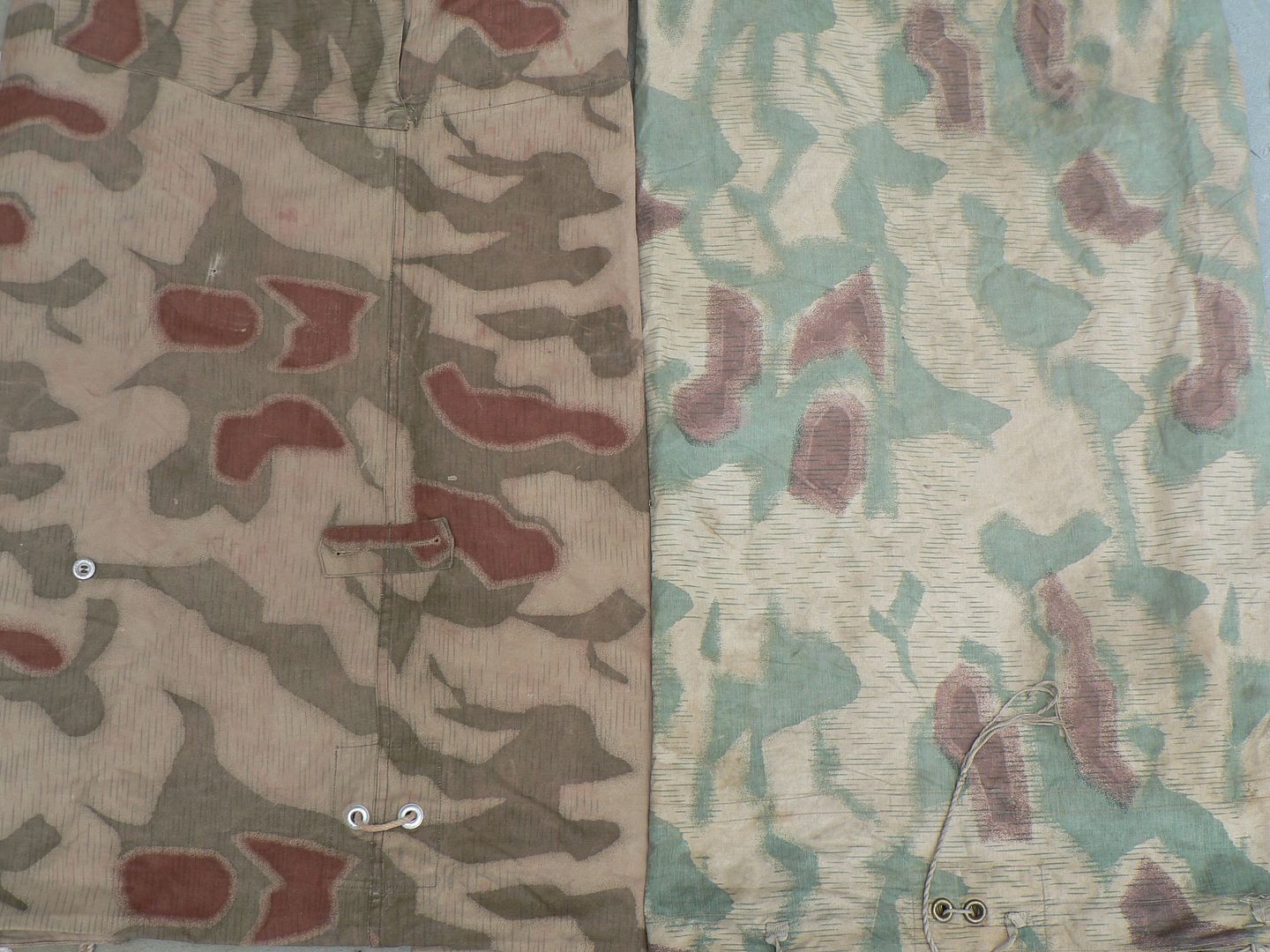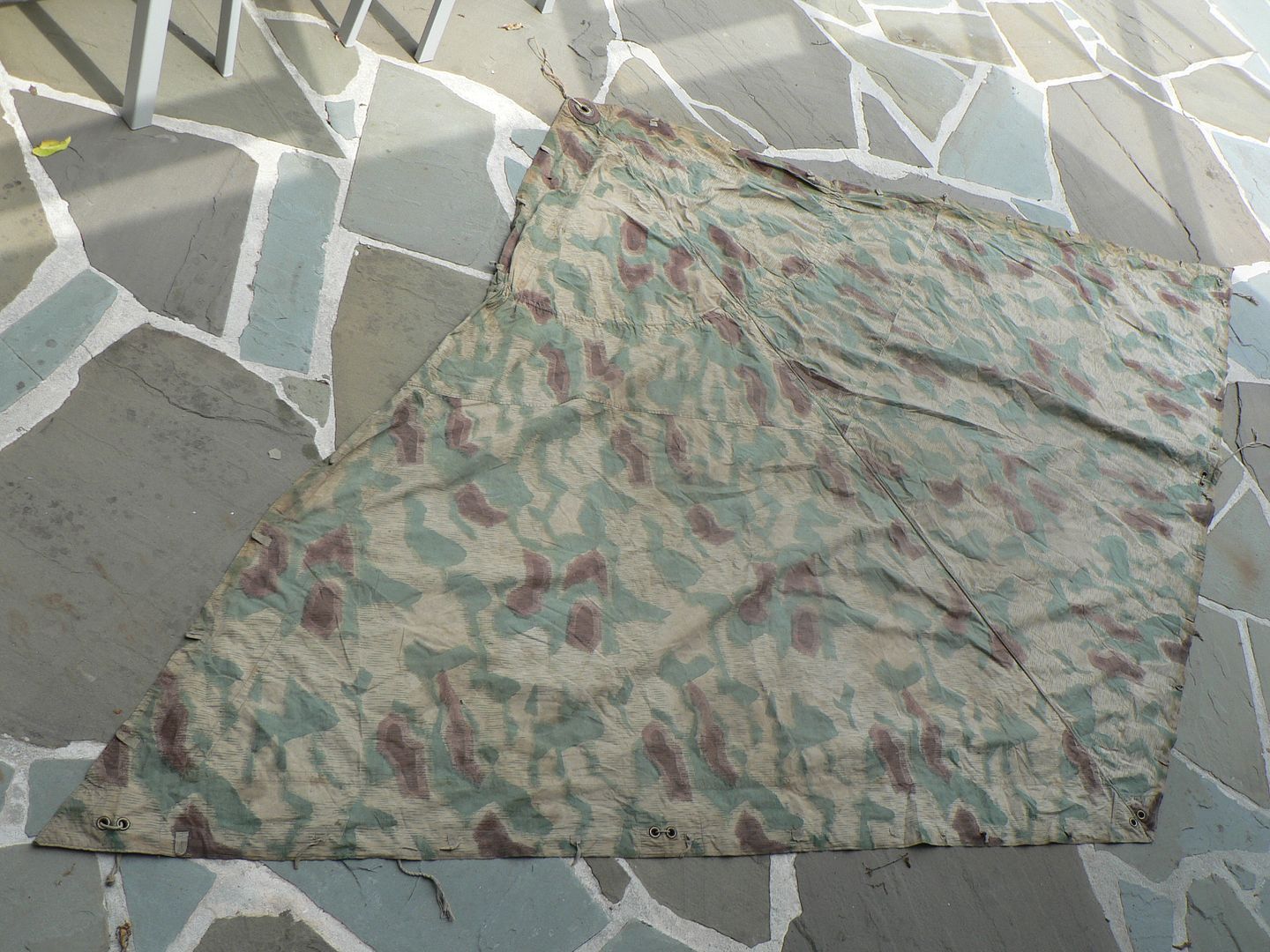I don't post much on this forum but I figured this would be of interest as they are almost never encountered. This is one of the very early postwar zeltbahns made by the Czechs using German Sumpfmuster 44 print rollers. I don't think anybody knows for sure but I think it's safe to say that very few of these were ever made and, judging by how thin the material is, there are even fewer that have survived. ANywho, because they are so rarely encountered, I figured it would be nice to post some pictures for future reference.
This first one is a general comparison of the Czech pattern (right) compared to a postwar West German (left):

It is important to note that the Czechs later made a very similar pattern but it was still distinctly different and the elements (especially the russet colored ones) are much smaller. I don't have one of those for comparison but it you google "early postwar czech sumpftarn" you'll easily find images of that pattern.
Next up is a picture of the entire thing laid out:

It is not square but rather a parallelogram in shape and there is no arm pass through as seen on the later versions. Essentially, it's two triangles sewn together with a cord in the joint to give it strength.
Here's the reverse side:

I don't know why there are some lighter areas...maybe stains of some sort?? Notice the thin strip of cloth sewn on a few inches from the edge all the way around the perimeter. That's reinforcement for wooden toggle buttons that are supposed to be sewn on the printed side. There would be one toggle for every loop so that you could join multiple zelts together to make a tent or configure one to be used as individual camouflage or a rain cape. Unfortunately, this one has had all of its toggles removed so I can't show you an example of one.
I found two ink stamps but both are illegible. Here is one:

The brass fitting to the left of frame would be the apex of the tent. The idea was that you would fit your bayonet to your rifle and run it through this fitting. In this way, the rifle would act at a center pole for the tent. I'm assuming that you would then use a helmet on top of the tent German style to keep out the rain.
Here's the same stamp from a different angle:

The other stamp:

At least I THINK it's a stamp. It may just be staining. On a later Czech zelt I have, there are two separate stamps. One is in a box as seen on the first stamp illustrated above and the other is a crossed swords acceptance stamp and a date. If this one is marked in the similar fashion, I would guess this stamp (again, if it IS one) is probably the date. I really wish I could read it!
Here are a couple shots detailing the earlier mentioned reinforcement cord sewn into the seam where the two pieces of sloth meet:


Detail showing two brass grommets with a tie down still attached:

I assume this is for a tent peg. Notice the earlier mentioned reinforcement strip for the toggle buttons.
This first one is a general comparison of the Czech pattern (right) compared to a postwar West German (left):

It is important to note that the Czechs later made a very similar pattern but it was still distinctly different and the elements (especially the russet colored ones) are much smaller. I don't have one of those for comparison but it you google "early postwar czech sumpftarn" you'll easily find images of that pattern.
Next up is a picture of the entire thing laid out:

It is not square but rather a parallelogram in shape and there is no arm pass through as seen on the later versions. Essentially, it's two triangles sewn together with a cord in the joint to give it strength.
Here's the reverse side:

I don't know why there are some lighter areas...maybe stains of some sort?? Notice the thin strip of cloth sewn on a few inches from the edge all the way around the perimeter. That's reinforcement for wooden toggle buttons that are supposed to be sewn on the printed side. There would be one toggle for every loop so that you could join multiple zelts together to make a tent or configure one to be used as individual camouflage or a rain cape. Unfortunately, this one has had all of its toggles removed so I can't show you an example of one.
I found two ink stamps but both are illegible. Here is one:

The brass fitting to the left of frame would be the apex of the tent. The idea was that you would fit your bayonet to your rifle and run it through this fitting. In this way, the rifle would act at a center pole for the tent. I'm assuming that you would then use a helmet on top of the tent German style to keep out the rain.
Here's the same stamp from a different angle:

The other stamp:

At least I THINK it's a stamp. It may just be staining. On a later Czech zelt I have, there are two separate stamps. One is in a box as seen on the first stamp illustrated above and the other is a crossed swords acceptance stamp and a date. If this one is marked in the similar fashion, I would guess this stamp (again, if it IS one) is probably the date. I really wish I could read it!
Here are a couple shots detailing the earlier mentioned reinforcement cord sewn into the seam where the two pieces of sloth meet:


Detail showing two brass grommets with a tie down still attached:

I assume this is for a tent peg. Notice the earlier mentioned reinforcement strip for the toggle buttons.



















 The last thing I want to touch on is colors. Obviously, this thing is very old and has seen real use. Itshould go without saying that it is faded. The question is.....how faded? The short answer is that I have absolutely no idea. What I do know is that the tan background is darker in some places around the perimeter and it closely approximates the color used during the war. Now, whether the darker areas are staining or non faded I simply cannot say. What I can say is that I don't believe this is made from cloth leftover from the war because it is much thinner than any wartime zeltbahn I have encountered. So I believe this was manufactured postwar. But just because the Czechs used German equipment to print it doesn't mean they used the same colors. Whatever the case, below are examples of some darker edges compared to lighter areas. I leave it to the reader to decide for himself what the original hues were.
The last thing I want to touch on is colors. Obviously, this thing is very old and has seen real use. Itshould go without saying that it is faded. The question is.....how faded? The short answer is that I have absolutely no idea. What I do know is that the tan background is darker in some places around the perimeter and it closely approximates the color used during the war. Now, whether the darker areas are staining or non faded I simply cannot say. What I can say is that I don't believe this is made from cloth leftover from the war because it is much thinner than any wartime zeltbahn I have encountered. So I believe this was manufactured postwar. But just because the Czechs used German equipment to print it doesn't mean they used the same colors. Whatever the case, below are examples of some darker edges compared to lighter areas. I leave it to the reader to decide for himself what the original hues were.




Comment